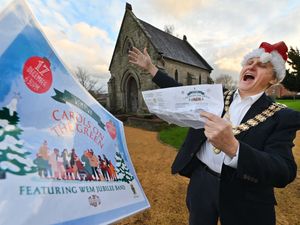Mystery of the missing bomber
Sixty-three years ago this month a Lancaster bomber with its crew of seven mysteriously disappeared over Shropshire. Toby Neal reports on one of Shropshire's enduring wartime mysteries.
 Sixty-three years ago this month, during the night of February 6 and 7, 1945, a Lancaster bomber with its crew of seven mysteriously disappeared over Shropshire. No wreckage was ever found and nothing was heard of the bomber or the men aboard ever again.
Sixty-three years ago this month, during the night of February 6 and 7, 1945, a Lancaster bomber with its crew of seven mysteriously disappeared over Shropshire. No wreckage was ever found and nothing was heard of the bomber or the men aboard ever again.
It is one of Shropshire's enduring wartime mysteries, a riddle which has never been solved.
But now Mr Donald Stokes, who celebrated his 85th birthday on the anniversary of that disappearance - and it is this which has made his recollections of that night stick so strongly in the memory - has come up with some new information which conjures up the possibility that the bomber may be lying, undiscovered, under the peat of Whixall Moss or neighbouring Fenns Moss, into which it sank without trace all those years ago.
Somewhat less likely, as some wreckage or oil would surely have floated to the surface to betray its presence, is the possibility that the bomber ditched in the darkness in The Mere, Ellesmere, and is lying at the bottom.
It is neither unknown nor unprecedented for an aircraft to be swallowed up by the ground in Shropshire.
In April 1941 two Miles Master training aircraft collided in mid air near Tern Hill airfield. One of them came down in swampy ground at Helshaw Grange and recovery efforts were abandoned as the aircraft sank deeper. The site was simply fenced off.
It was not until the autumn of 1978 that wartime aircraft recovery enthusiasts excavated the wreck and found the remains of the pilot.
It is only recently that Mr Stokes, who lives just north of The Mere at Ellesmere, became aware of the riddle of the missing Lancaster and, putting two and two together, realised that his vivid memories of a strange event that night might be a clue to its fate.
"I remember it because it was my birthday, February 6. In the middle of the night there was a tremendous engine noise. It woke me up and I went to the window. I wondered if it was a tank or something going down the road, the noise was so terrific," he said.
 "I went to the bathroom window to see if I could see anything. And then, after one-and-a-half minutes, the noise stopped. It did not fade away or die out. It stopped immediately and totally.
"I went to the bathroom window to see if I could see anything. And then, after one-and-a-half minutes, the noise stopped. It did not fade away or die out. It stopped immediately and totally.
"I have subsequently learned that it was on this night that a Lancaster bomber went missing over northern Shropshire.
"One-and-a-half minutes at a flying speed of 160 to 180mph, which is three miles a minute, would take it straight over Whixall Moss. Whixall Moss is a huge area.
"I had never heard an aircraft making that noise before. It was either engines at extreme power, or something wrong.
"I am only surmising, but how funny it is that an aircraft has never been found. It was not until I read of this total mystery that I thought that it happened this very night, my birthday night."
He has considered as an alternative theory that the bomber came down in The Mere, which is over 60ft deep.
"Surely wreckage or something would come to the top."
The mystery has also naturally puzzled Rob Davis of Telford, a researcher who has built up a huge database of Bomber Command losses, and has made an appeal for information about the fate of the Lancaster. The names of the crew are recorded on the Runnymede memorial for missing airmen.
The aircraft was based at Lindholme airfield, near Doncaster - it is now a prison - and was serving with 1656 Heavy Conversion Unit, which trained up crews in the ways of the Lancaster bomber in preparation for operations.
It took off for a night cross-country exercise and was last heard from at 0051 hours while, it is said, flying in the general vicinity of Shrewsbury.
The pilot was 31-year-old Flight Sergeant Robert Erskine Plante, of the Royal Australian Air Force, who hailed from Essendon, Victoria, Australia, and had survived a previous serious accident.
He is recorded as being killed along with the other six members of the bomber crew.
Even today, all these years on, there is a possibility that these wartime airmen who were last heard of over Shropshire may one day be found and be given a fitting funeral.
By Toby Neal





